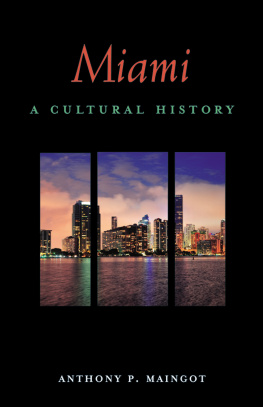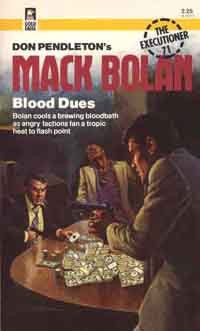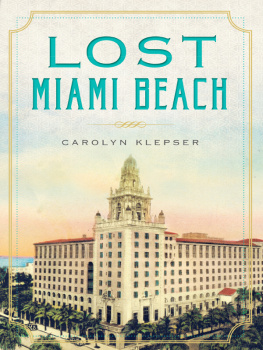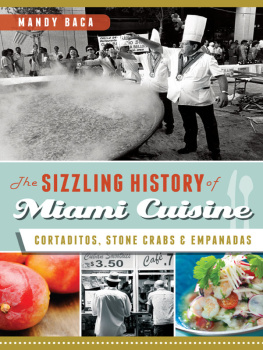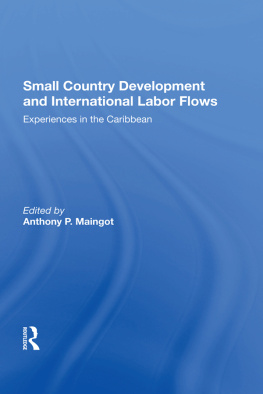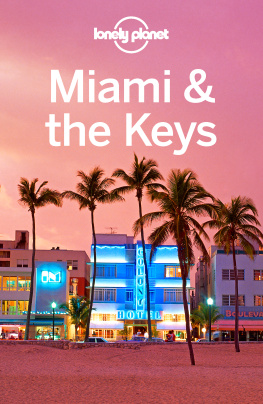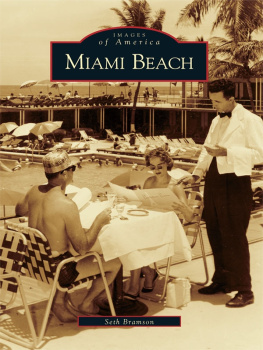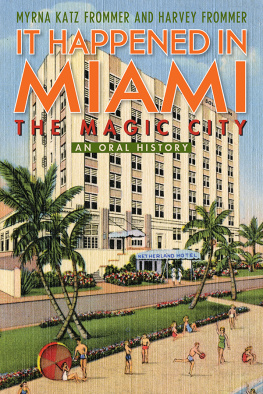MIAMI
Also in the series
Buenos Aires by Jason Wilson
Oxford by David Horan
Mexico City by Nick Caistor
Rome by Jonathan Boardman
Madrid by Elizabeth Nash
Venice by Martin Garrett
Lisbon by Paul Buck
Havana by Claudia Lightfoot
New York City by Eric Homberger
Brussels by Andr de Vries
Prague by Richard Burton
Calcutta by Krishna Dutta
Edinburgh by Donald Campbell
San Francisco by Mick Sinclair
Cambridge by Martin Garrett
Helsinki by Neil Kent
Kingston by David Howard
Athens by Michael Llewellyn Smith
Istanbul by Peter Clark
Hamburg by Matthew Jefferies
Lagos by Kaye Whiteman
First published in 2015 by
INTERLINK BOOKS
An imprint of Interlink Publishing Group, Inc.
46 Crosby Street, Northampton, Massachusetts 01060
www.interlinkbooks.com
Copyright Anthony P. Maingot, 2015
Cover images Songquan Deng/istockphoto; Wikipedia Commons
Illustrations HistoryMiami Archives pp.15, 20, 56, 79, 112, 131; Wikimedia Commons
pp.i, 7, 12, 14, 18, 22, 30, 32, 35, 70, 76, 90, 101, 107, 120, 123, 144, 162, 166, 176,
178, 181, 184, 189, 195, 217; DesignMiami p.203; Library of Congress pp.43, 66, 146;
Florida Division of Library and Information Services p.51; spirit of
America/shutterstock p.172; Gregory Witczak/istockphoto p.221;
www.brickellinfo.com; Anthony P. Maingot p.93
All rights reserved. The whole of this work, including all text and illustrations, is protected by copyright. No parts of this work may be loaded, stored, manipulated, reproduced or transmitted in any form or by any means, electronic or mechanical, including photocopying and recording, or by any information, storage and retrieval system without prior written permission from the publisher, on behalf of the copyright owner.
Library of Congress Cataloging-in-Publication Data available
ISBN 978-1-56656-983-5
Printed and bound in the United States of America
To request our 48-page, full-color catalog, please call us toll free at 1-800-238-LINK, visit our website: www.interlinkbooks.com, or send us an email: info@interlinkbooks.com
Contents
G RAND AND G RANDIOSE
City in Flux
C ONQUERING THE N ORTHERN F RONTIER : S ETTLING S OUTH F LORIDA
The Earliest Settlers; Birth of Miami; Pioneers andRailroads; Boom Time; Age of Aviation; Historyand Myth
P ROHIBITION, THE D EPRESSION, AND W ORLD W AR II: F ROM B ACKWATER TO O PEN C ITY
Prohibition and Progress; Grand Schemes; Boom toBust; The War Years; International Hub
T HE B ATTLES AGAINST J IM C ROW AND O RGANIZED C RIME : U NFINISHED A GENDAS
Racists and Reformers; Al Capone and the Mob; WaltDisney and the New Economy; Meyer Lansky and the BahamasConnection; Tentacles of Crime; A PhilanthropicBootlegger
A LEGRA T ROPICAL : C UBAN N OSTALGIA AND THE C HARACTER OF M IAMI
The Lure of the Tropics; Money and Politics; The CastroGeneration; The Cuban Miracle
W ORLDS A PART : P UERTO R ICANS AND H AITIANS IN A R ACIALLY U NSETTLED C ITY
The Haitian Exodus; Riots and Resentment; House ofLies
M IAMI V ICE AND M IAMI N ICE : F ICTION AND R EALITY
Literature of Nostalgia; Miami Noir ; Cops andRobbers; Carl Hiaasen: Amiable Depravity;Blowback; Dirty Money; Good Guys
H IGH AND L OW C ULTURE : A RCHITECTURE , E DUCATION, AND T URF
A Tour of Miami, Modern and Less Modern; Downtown;Cuban Culture; Miami Cuisine; City of Music;High Culture; Project Fever; Cultural Renaissance: ArtBasel
C ITY OF THE F UTURE : G LOBAL OR C OSMOPOLITAN ?
Banana Republic?; The Cuban Paradox; Gambling on theFuture; Conclusion: Across the Straits
Foreword
Many of the historical and social changes that Tony Maingot describes in this book may be visible to an observant visitor to Miami. But that visitor will also have other, more general, questions: how did Miami become what it is today? What are the citys outstanding characteristics, good and bad? What is its future likely to bring? Will it be yet another Hispanic city of the US, or will Miami-Dade be a unique sub-region? Maingot answers these questions, and that is why this book is so relevant.
A bit of autobiography. I have been both a witness to and a participant in the evolution of this city. I was a University of Miami graduate in the late 1950s, a Florida State Legislator in the mid-1960s, City of Miami Commissioner in the late 1960s, and Mayor of the City of Miami from 1973 to 1985. In the mid-1990s I was a Miami-Dade County (MDC) Commissioner. I have served on the Miami-Dade Expressway Authority for seven years and currently serve on the Florida Transportation Commission, which oversees all surface, sea, and air transportation issues in our state. In the 26 years I have given to public service in Florida, I have focused on two urban areas: the internationalization of Miami and its infrastructure. It is my strong belief that Miamis future is not only as a gateway to Latin America and the Caribbean, but also as a trading center. A trading center exists not only to buy and sell goods and services, but for a much wider interchange of knowledge, technology, and education. None of the above can happen unless Miami and Florida have the airports, sea-ports, downtown commercial infrastructure, roads and highways, public transportation, and transit systemsboth urban, intra, and interstateneeded for the future. Infrastructure compliance also requires the build-up of educational institutions, cultural centers, and entertainment amenities that will make Miami unique.
In many ways the existence of Miami is circumstantial. Its founding was a fluke that would not have occurred had Henry Flagler not extended his Florida East Coast Railroad south from its original terminus at Palm Beach in 1896. Nor would Miami exist but for the advent of electricity to work the pumps, to make it mosquito free, to drain and keep dry the re-claimed marsh areas of the Eastern Everglades, and to work our air con-ditioners and elevators. Modern Miami could not survive without its airports and seaports. There is no community in the world of almost six million people (South Florida), with over 25 million visitors annually, whose economy is so dependent on its airports and seaports.
There was a time when Miami had the illusion of competing with Atlanta as the capital of the US South. That dream is long gone. Now Atlanta, Orlando, Houston, and others want to compete with Miami as the gateway to Latin America. These aspirations are possible but highly improbable because of geography, demography, and the historical cir-cumstances of Miami.
As Mayor of Miami I dealt with such traumatic events as the race riots and civil disturbances of the early 1980s, the drama of Mariel, the arrival of many Haitian boatpeople, and the cocaine cowboy shoot-outs in local parking lots. I have lived through the modern metamorphosis of Miami. This has led me to pay special attention to what both Miamians think of their city and what serious outsiders say about it.
Among the first things to note are the demographic changes and political ramifications that the ongoing Latinization of Miami has caused in Florida. Arguably, most important in 2012 is that the Cuban-American vote statewide continues to decrease proportionately. Ten years ago Cuban-Americans made up almost two-thirds of the Hispanic vote in Florida. In 2008 they accounted for 40 percent, and today Cuban-Americans represent only 36 percent of the 1,473,920 Latino voters registered in Florida, 13.1 percent of all Florida registered voters. One of the fastest growing groups is comprised of neither refugees nor immigrants, but US citizens moving to Florida. Caribbean Business , a respected weekly periodical based in Puerto Rico, reports that the Puerto Rican population of Florida has surged by 75 percent in the last decade to 850,000 of whom 350,000 moved from the island during that period. Interestingly, most of the adults moving north are college graduates with a profession or trade, and they are moving mostly to the Orlando area. For those coming to Miami, what kind of city will they find?

